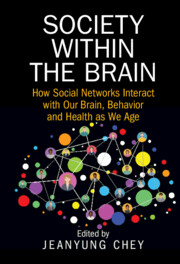Book contents
- Society within the Brain
- Society within the Brain
- Copyright page
- Dedication
- Contents
- Figures
- Tables
- Contributors
- Preface
- Introduction
- Part I Approaches to Society within the Brain
- Part II Society Interacting with Brain, Cognition, and Health in Late Life
- Part III An Individual’s Cognitive Aging with Others: Key Findings, Issues, and Implications
- Chapter 9 Social Relationships and Cognitive Function in Older Adults
- Chapter 10 Social Network and the Brain
- Chapter 11 Origins of Individual Differences in Social Behavior and the Social Brain
- Chapter 12 Preventing Dementia with Social Connection
- Index
- References
Chapter 9 - Social Relationships and Cognitive Function in Older Adults
from Part III - An Individual’s Cognitive Aging with Others: Key Findings, Issues, and Implications
Published online by Cambridge University Press: 28 September 2023
- Society within the Brain
- Society within the Brain
- Copyright page
- Dedication
- Contents
- Figures
- Tables
- Contributors
- Preface
- Introduction
- Part I Approaches to Society within the Brain
- Part II Society Interacting with Brain, Cognition, and Health in Late Life
- Part III An Individual’s Cognitive Aging with Others: Key Findings, Issues, and Implications
- Chapter 9 Social Relationships and Cognitive Function in Older Adults
- Chapter 10 Social Network and the Brain
- Chapter 11 Origins of Individual Differences in Social Behavior and the Social Brain
- Chapter 12 Preventing Dementia with Social Connection
- Index
- References
Summary
Cognitive health is one of the most important determinants of the quality of life and functional independence in older adults. Recently, social relationships have emerged as a protective factor against neurocognitive disorders and cognitive decline in old age. This chapter reviews the literature investigating the influence of structural and functional aspects of social relationships on dementia risk and cognitive function in older adults. For the structural aspects, it includes studies on the effects of social networks, social contacts, and social activity participation on cognitive function in older adults. For the functional aspects, it notes the influences of social support, social conflict, and loneliness on dementia risk and cognitive aging. Lastly, the chapter discusses the potential factors that mediate or modulate the relationship between social relationships and cognitive function.
Keywords
- Type
- Chapter
- Information
- Society within the BrainHow Social Networks Interact with Our Brain, Behavior and Health as We Age, pp. 195 - 216Publisher: Cambridge University PressPrint publication year: 2023



